Tucked away from the bustle of colonial Kolkata, Bolpur’s red-earth landscape became home to Santiniketan in 1863, when Maharshi Devendranath Tagore purchased the land and established a spiritual retreat he named the “Abode of Peace.”
His son, Rabindranath Tagore, later expanded the ashram into an educational centre, beginning with the Brahmacharyasrama school in 1901. This vision culminated in 1921 with the founding of Visva-Bharati University, home to institutions like Cheena Bhavan, a hub for global exchange of knowledge and culture. The name, meaning “the communion of the world with India,” perfectly captured Tagore’s ideal.
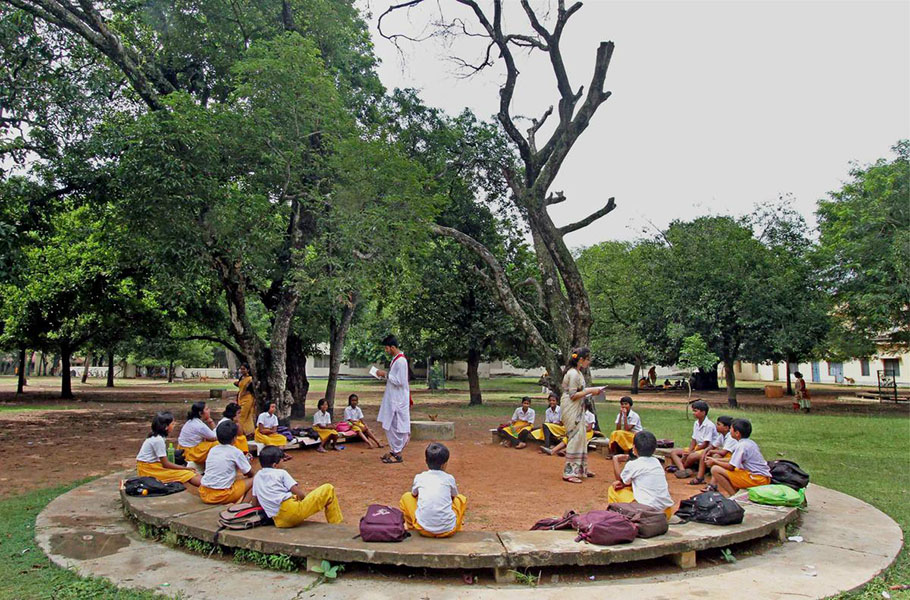
Students studying at Santiniketan University (Image credits: The Hindu)
Among the many institutions housed within Visva Bharati, Cheena Bhavan, the Institute of Chinese Language and Culture, stands out as a powerful symbol of intercultural exchange. It was envisioned and established by Chinese scholar Tan Yun-Shan, who played a key role in introducing Chinese philosophy, language, and literature into the academic and cultural life of the university.
RABINDRANATH TAGORE’S VISION FOR VISVA BHARATI
Tagore was many things: a poet, philosopher, musical composer, and the first Asian Nobel Laureate, but he was also a visionary, passionate about creating a place where learning was open to all. He envisioned a university rich with wisdom, ideas, and culture, drawing not only from India but from across the world.
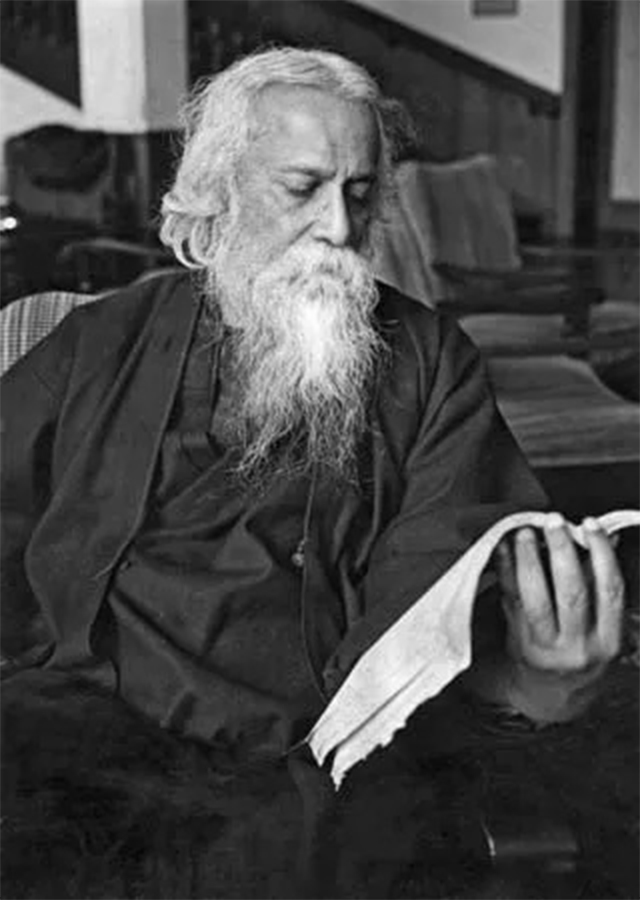
Rabindranath Tagore (Image credits: Encyclopædia Britannica, Inc.)
The environment at Visva Bharati is central to its identity; the campus feels endless, spread across two towns. Defined by its exquisite architecture and beautiful flora stretched across miles, the place has long influenced the people who work, learn, and create there.
Tagore’s vision with Visva Bharati was unlike any other institution at the time, a setting where learning unfolded among trees, fields, open-air classes, and gardens. He believed in the educational value of nature, which is beautifully evinced in the character of this place, something that the country had never experienced before.
“The highest education is that which does not merely give us information but makes our life in harmony with all existence.”
- Tagore (1)
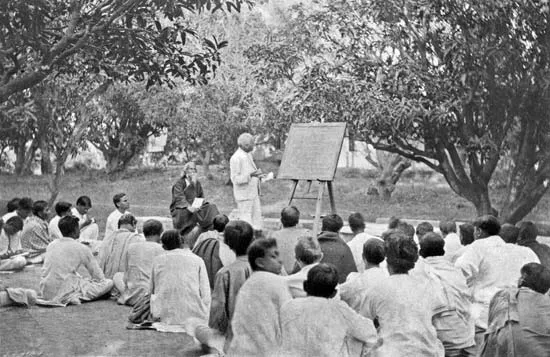
Open-air classroom at Santiniketan with Rabindranath Tagore
(seated, to the left of man at blackboard) (Image credits: Encyclopædia Britannica, Inc.)
Visva-Bharati was a vibrant learning community that welcomed children from all backgrounds, and, in a pioneering move for pre-independent India, invited women not only to study but also to teach.

Rabindranath Tagore with teachers in Santiniketan,1940
Tagore’s vision of education for all was deeply woven into Visva-Bharati’s values. The institution welcomed everyone, regardless of caste, colour, culture, gender, or economic background, and opened its doors free of cost to those unable to pay fees. Students extended this spirit beyond the campus, running night schools in nearby villages for marginalised communities and breaking long-standing social barriers. They also managed a dairy farm, post office, hospital, and workshops, embodying Tagore’s belief in education as a holistic preparation for life. (1)
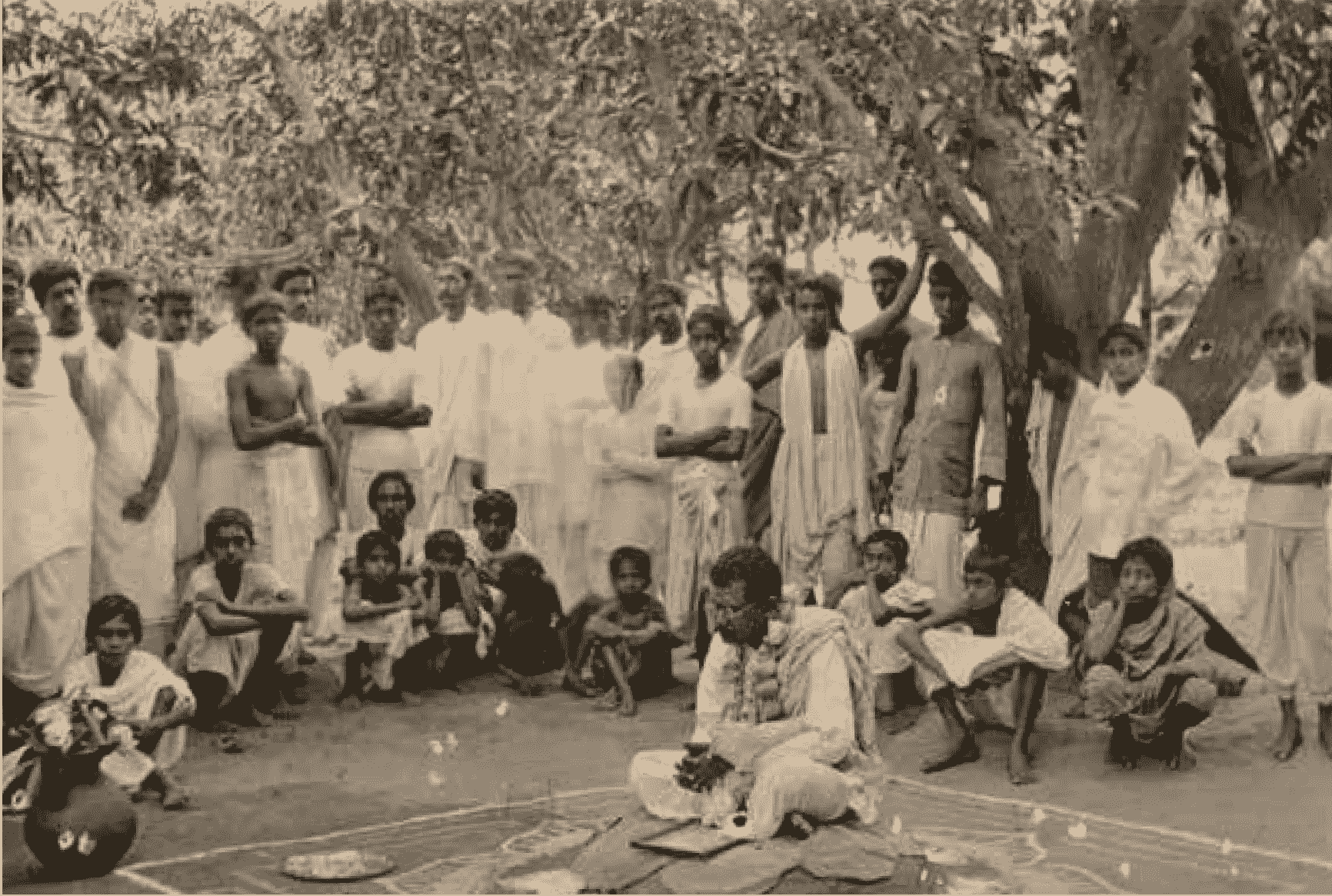
Early days in Santiniketan’s cultural life
He once said, “In every nation, education is intimately associated with the life of the people. For us, modern education [...] has not reached the farmer, the oil grinder, nor the potter. If ever a truly Indian university is established it must from the very beginning implement knowledge of economics, agriculture, health, medicine and of all other everyday science from the surrounding villages. Then alone can the school or university become the center of the country’s way of living. This school must practice agriculture, dairying and weaving using the best modern methods.” (1)
INDIA AND CHINA CULTURAL EXCHANGE
For over 2,000 years, India and China, two of the world’s oldest civilizations, have shared a rich legacy of cultural, artistic, and literary exchange. Despite the political differences at the time, Tagore had great regard for China, its people, and heritage.
Tagore was invited to China in 1924 by Jiangxue She (Beijing Lecture Association), a Chinese organisation formed by a group of intellectuals who hosted scholars from all over the world to deliver lectures. Prodigies like John Dewey, Bertrand Russell, Paul Munroe, and Hans Driesch had been welcomed here before. (2)
Tagore traversed various cities in China to deliver speeches on Indian culture and civilization. He often expressed a desire to deepen the relationship between the countries. In one of his lectures, he said:
“My friends, this is my mission. I have come to ask you to reopen the channel of communication which I hope is still there; for though overgrown with weeds of oblivion, its lines can still be traced. I shall consider myself fortunate if, through this visit, China comes nearer to India and India to China, — for no political or commercial purpose, but for disinterested human love and for nothing else.”
- Address to students at Hangchow. (3)
This visit left a deep impact on him.
Led by a chance encounter, he crossed paths with Chinese scholar, Prof. Tan Yun Shan, during one of his travels to Malaysia in 1927. Tan was inspired by the Bengali poet’s vision for Visva-Bharati as a centre of intercultural appreciation. Their shared interest in exploring Sino-Indian cultural cooperation led to their collaboration in establishing the Cheena Bhavan in the following years.
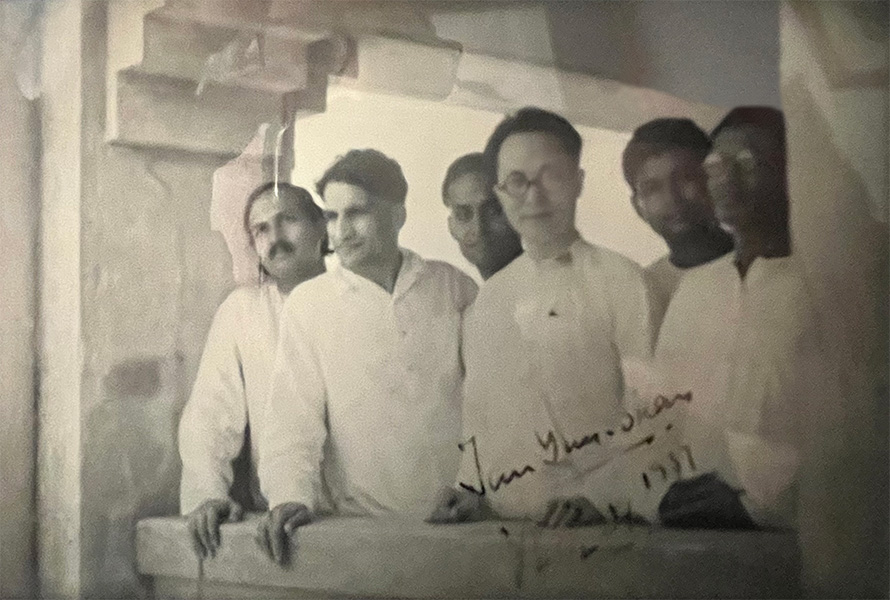
Tan Yun Shan (centre first row)
CHEENA BHAVAN
Upon Tagore’s invitation, Prof. Tan Yun-Shan travelled to Santiniketan in 1928 to join Visva-Bharati as a professor of Chinese cultural studies. He began with just five students: three college teachers and two researchers, but soon recognised the need for a dedicated hall for his work. With Visva-Bharati operating on limited funds as a private institution, Tan took it upon himself to raise the necessary resources for the project.
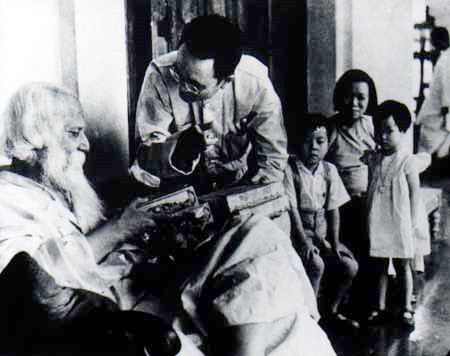
Rabindranath Tagore with Prof. Tan Yun-Shan at Visva Bharati
(Image credits: SMARAKA GRANTHA)
He travelled to China in 1931, securing Rs. 50,000 for the hall. Over the next few years, with the support of the Sino-Indian Cultural Society, he amassed more than 1,50,000 books. By 1936, he returned to India with both the funds and the collection, ready to bring his idea to life. The Sino-Indian cultural society was founded in Nanjing, China, in 1933 by Prof.Tan. Cheena Bhavan, formed a few years later, became the Indian interpretation of this Society. (3)
Tagore, being exhilarated by Prof. Tan’s acquisition, allotted him land within Santiniketan to construct the Chinese hall. Tan supervised the construction of this building and personally planted trees surrounding the property, bringing the hall to life. On 14th April, 1937, Cheena Bhavan was officially inaugurated by Indira Gandhi. (4)
“This is, indeed, a great day for me, a day long looked for, when I should be able to redeem, on behalf of our people, an ancient pledge implicit in our past, the pledge to maintain the intercourse of culture and friendship between our people and the people of China, an intercourse whose foundations were laid eighteen hundred years back by our ancestors with infinite patience and sacrifice.”
-Rabindranath Tagore (5)
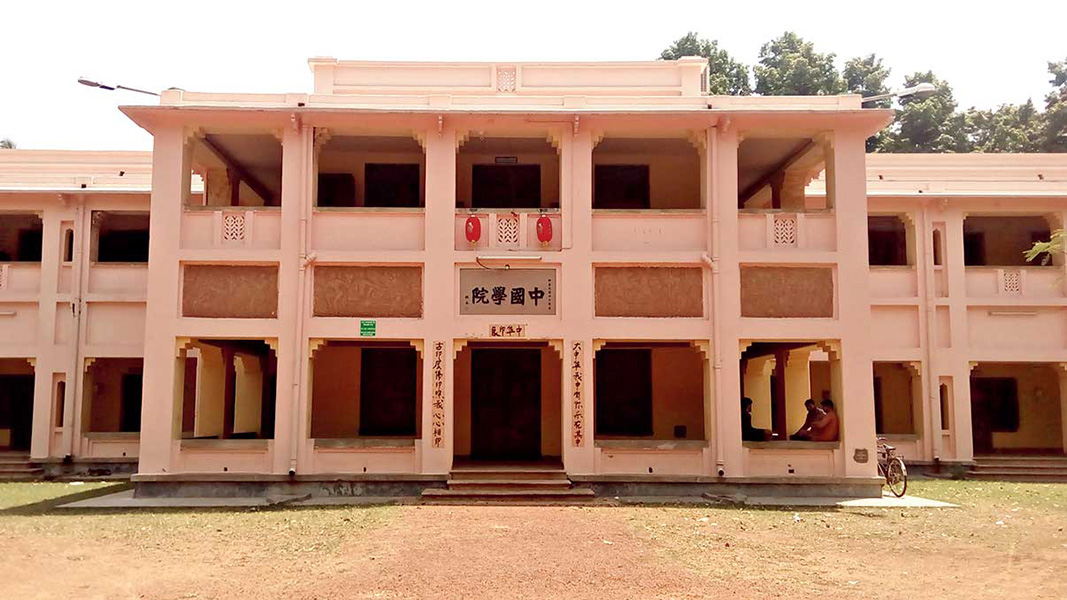
Cheena Bhavan (Image credits: Telegraph India)
The two-tiered building displays a Chinese sign reading ‘Zhongguo xueyuan’ (China Academy) and a plaque at the front noting the year of its formation. It houses a library, auditorium, offices, classrooms, research rooms, a reading room, and accommodations for students and staff. The architecture, supervised by Tan Yun Shan in collaboration with artist-architect Surendranath Kar, renowned for blending Indian styles with Western and Eastern influences, presents a serene vision of traditional Chinese design, with pagoda-style roofs and elaborate woodwork across the structure.
Today, Cheena Bhavan thrives as a vibrant hub of learning, offering programs in language, research, and cultural heritage, enriched by its vast library of Chinese manuscripts, books, artworks, Buddhist scriptures, and journals. Its halls regularly come alive with exhibitions, seminars, and workshops, sustaining the spirit of exchange that shaped its origins.
For decades, the institute, alongside Visva-Bharati, has welcomed renowned Chinese scholars as visiting professors, lecturers, and guests, deepening the dialogue between the two nations. Among them was Xu Beihong, often hailed as the father of modern Chinese painting, who became the first Chinese visiting professor at Kala Bhavana, the University’s School of Art.
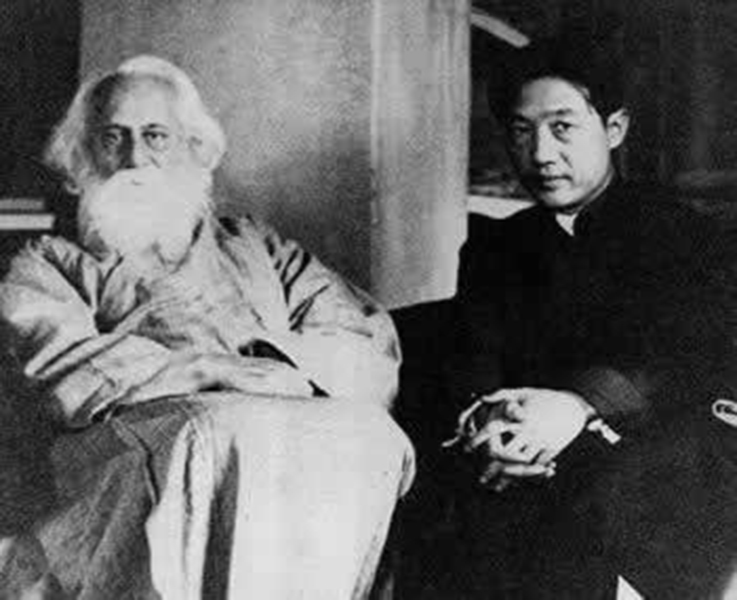
Rabindranath Tagore and Xu Beihong in Santiniketan
(Image credits: ICS Research Blog)
With its inauguration, Tagore set Visva-Bharati on a path to become a benchmark in Indian education, one committed to sustained collaboration with China and the preservation of centuries-old cultural bonds.
Cheena Bhavan remains a living bridge between ancient exchanges and modern diplomacy, most recently welcoming Xu Feihong, Ambassador of the People’s Republic of China, in June 2025. As M.K. Gandhi wrote to Tagore in 1937, the institute stands as “a symbol of living contact between China and India”, a sentiment that continues to resonate today. (6)

M.K. Gandhi at Santiniketan in 1940
REFERENCES
- Melanie R. Clark, Design without Borders: Universalism in the Architecture of Rabindranath Tagore’s “World Nest” at Santiniketan (Brigham Young University)
- Reena Ganguli, Tagore and China, Volume 25, Issue 3
- W. Pachow, IN THE FOOTSTEPS OF XUANZANG: TAN YUN-SHAN AND INDIA
- Tan Chung, IN THE FOOTSTEPS OF XUANZANG: TAN YUN-SHAN AND INDIA
- Cheena Bhavana, Visva-Bharati
- Brian Tsui, When Culture Meets State Diplomacy: The Case of Cheena Bhavana
- Santiniketan - Wikipedia
- Unraveling the Enigma of Santiniketan: Exploring its Fame and Significance, santiniketan.com
- The Architectural Marvels of Shantiniketan, cassolution, 2024
- Avijit Banerjee, Making India–China Connections: Tagore and Cheena Bhavan
- Tan Yun-Shan (1898-1983), visvabharati official website
- Cheena Bhavana: Sino-Indian Cultural Hub, bolpur-santiniketan.com
- Santiniketan, UNESCO